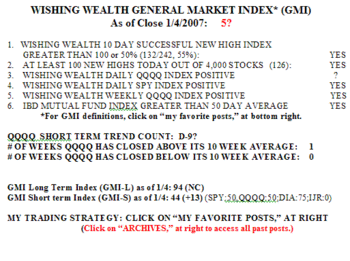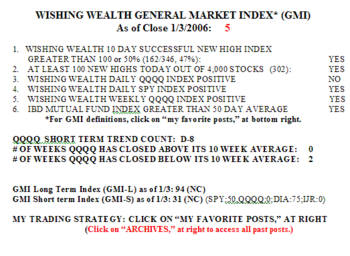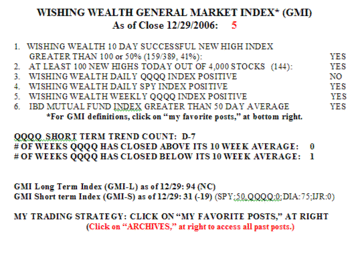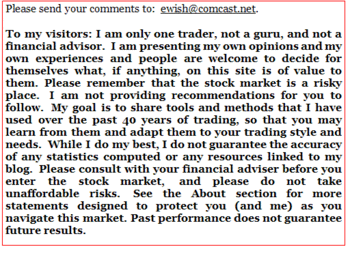The GMI is 5 with a "?" The GMI-S rose to 44, with improvement in the QQQQ short term indicators. It is too early to tell if the Daily QQQQ Index has turned positive.  The short term QQQQ trend is just too difficult to decipher. There were only 126 new 52 week highs in my universe of 4,000 stocks. However, 80% of the Nasdaq 100 stocks rose, but only 48-50% of the S&P 500 and Dow 30 stocks. Clearly this was a schizoid market. Only 56% of the IBD 100 stock list from 12/18 advanced. So the gain on Thursday was mainly in the large tech stocks in the Nasdaq 100 index. The leaders, RIMM, GOOG and AAPL all looked good, for a change. With the market trend so murky, I sold my QID with a loss and went to 100% cash. This is not the time for me to make large bets on the QQQQ trend.
The short term QQQQ trend is just too difficult to decipher. There were only 126 new 52 week highs in my universe of 4,000 stocks. However, 80% of the Nasdaq 100 stocks rose, but only 48-50% of the S&P 500 and Dow 30 stocks. Clearly this was a schizoid market. Only 56% of the IBD 100 stock list from 12/18 advanced. So the gain on Thursday was mainly in the large tech stocks in the Nasdaq 100 index. The leaders, RIMM, GOOG and AAPL all looked good, for a change. With the market trend so murky, I sold my QID with a loss and went to 100% cash. This is not the time for me to make large bets on the QQQQ trend.
GMI: 5; Nasdaq 100 index weak
The GMI remains at 5. 54-60% of the stocks in the Nasdaq 100, S&P 500 and Dow 30 indexes advanced on Wednesday.  There were 33 new 52 week lows in my universe of 4,000 stocks, the largest number since November 2. Wednesday was the 8th day in the current QQQQ down-trend. Given the rapid retreat from Wednesday’s highs, do we need more evidence that this market is topping? The leaders, AAPL, RIMM and GOOG continue to weaken. I am slowly accumulating QID as the QQQQ down-trend continues.
There were 33 new 52 week lows in my universe of 4,000 stocks, the largest number since November 2. Wednesday was the 8th day in the current QQQQ down-trend. Given the rapid retreat from Wednesday’s highs, do we need more evidence that this market is topping? The leaders, AAPL, RIMM and GOOG continue to weaken. I am slowly accumulating QID as the QQQQ down-trend continues.
See my disclaimers at the bottom of my prior post.
GMI: 5; GMI-S: 31; The Dow’s dirty little secret;
We keep hearing about how the Dow is at an all-time high. I looked at the price range of the 30 Dow stocks since the bubble top in 2000. Was I surprised to find that only 10 of the 30 stocks (33%) surpassed their 1999/2000 top in 2006: CAT, XOM, BA, AXP, JNJ, MO, C, UTX, MMM and PG. The fact that the Dow 30 average reached an all time high in 2006 is meaningless when 20 of the 30 stocks never got above their 1999/2000 bubble peaks! It all boils down to media hype to get unsuspecting investors to enter this record high market …
Meanwhile the GMI closed on Friday at 5 but the GMI-S fell 19, to 31.  With the media talking about another great year, it is interesting that my short term indicators for the Nasdaq 100 stocks and the S&P 600 Small Cap stocks are all negative. Only 18% of the Nasdaq 100 and S&P 500 stocks rose on Friday, along with 23% of the Dow 30 stocks. Just 33% of the Nasdaq 100 stocks have closed above their 30 day averages. Only 18% of the IBD 100 list from 12/18 advanced and only 29% closed higher than they did on 12/18. Friday was the 7th day in the current QQQQ down-trend.
With the media talking about another great year, it is interesting that my short term indicators for the Nasdaq 100 stocks and the S&P 600 Small Cap stocks are all negative. Only 18% of the Nasdaq 100 and S&P 500 stocks rose on Friday, along with 23% of the Dow 30 stocks. Just 33% of the Nasdaq 100 stocks have closed above their 30 day averages. Only 18% of the IBD 100 list from 12/18 advanced and only 29% closed higher than they did on 12/18. Friday was the 7th day in the current QQQQ down-trend.
So, rather than try to predict the market, we need to look at what the market is doing now. The Nasdaq 100 stocks clearly are in a short term down-trend. The past leaders, RIMM, AAPL and GOOG, all look tired, and it has been several weeks since they hit new highs. Since the QQQQ hit a new high on 11/24, it has fallen 3.34% and 63% of the Nasdaq 100 stocks have declined. In fact, only 26% of the Nasdaq 100 stocks are up 1% or more since 11/24. With odds like these, I am mainly in cash and ready to accumulate more QID if the QQQQ continues to weaken.
